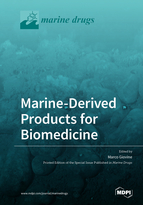Marine-Derived Products for Biomedicine
A special issue of Marine Drugs (ISSN 1660-3397).
Deadline for manuscript submissions: closed (7 May 2020) | Viewed by 57831
Special Issue Editor
Interests: marine collagen; porifera; biosilica; spongin; wound healing; tissue regeneration; jellyfish
Special Issues, Collections and Topics in MDPI journals
Special Issue Information
Dear Colleagues,
Marine biodiversity is a planetary resource of which sustainable exploitation is one of the keys of a blue economy. Among the treasures guarded by Poseidon, the great variety of organisms living in the Earth’s seas is an invaluable source of natural compounds and biomaterials that are potentially useful for biomedicines. New biologically-active compounds, exploited for new drug discovery, biomaterials used in tissue engineering and in bone repair, and complex body structural organizations for biomimicry are typical examples of applications of marine-derived products.
Marine invertebrates are the best candidates for active natural compound identification and for the characterization of new biomaterials, but a remarkable reservoir of new compounds come also from algae, as well as microorganisms.
An updated overview on the compounds and materials of marine origin for biomedicine will be reported in this Special Issue. Studies on new molecules derived from marine invertebrates and bacteria will be shown, as well as in vitro tests to assay the biotechnological potentiality of marine biomolecules for TERM and bone repairs.
Prof. Dr. Marco Giovine
Guest Editor
Manuscript Submission Information
Manuscripts should be submitted online at www.mdpi.com by registering and logging in to this website. Once you are registered, click here to go to the submission form. Manuscripts can be submitted until the deadline. All submissions that pass pre-check are peer-reviewed. Accepted papers will be published continuously in the journal (as soon as accepted) and will be listed together on the special issue website. Research articles, review articles as well as short communications are invited. For planned papers, a title and short abstract (about 100 words) can be sent to the Editorial Office for announcement on this website.
Submitted manuscripts should not have been published previously, nor be under consideration for publication elsewhere (except conference proceedings papers). All manuscripts are thoroughly refereed through a single-blind peer-review process. A guide for authors and other relevant information for submission of manuscripts is available on the Instructions for Authors page. Marine Drugs is an international peer-reviewed open access monthly journal published by MDPI.
Please visit the Instructions for Authors page before submitting a manuscript. The Article Processing Charge (APC) for publication in this open access journal is 2900 CHF (Swiss Francs). Submitted papers should be well formatted and use good English. Authors may use MDPI's English editing service prior to publication or during author revisions.
Keywords
- bioactive molecules
- biomaterials
- marine invertebrates
- marine bacteria
- symbionts







